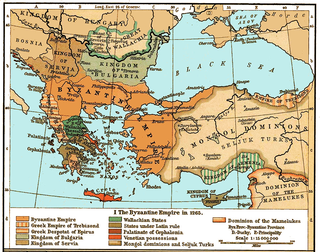Bibliography
- Loenertz, Raymond-Joseph (1975). Les Ghisi, dynastes vénitiens dans l'Archipel (1207-1390) (in French). Florence: Olschki.
The Ghisi family was a Venetian noble family, originally from Padua or Aquileia. Following the establishment of Crusader states in Greece after the Fourth Crusade, the Ghisi became an important dynasty there. Andrea Ghisi became lord of the islands of Tinos and Mykonos, while his brother Geremia Ghisi became ruler of Skopelos, Skiathos, and Skyros. Later members of the family were also active in the Principality of Achaea and the Triarchy of Negroponte.
Year 1341 (MCCCXLI) was a common year starting on Monday of the Julian calendar.
Year 1311 (MCCCXI) was a common year starting on Friday of the Julian calendar.

The Duchy of the Archipelago, also known as Duchy of Naxos or Duchy of the Aegean, was a maritime state created by Venetian interests in the Cyclades archipelago in the Aegean Sea, in the aftermath of the Fourth Crusade, centered on the islands of Naxos and Paros. It included all the Cyclades. In 1537 it became a tributary of the Ottoman Empire, and was annexed by the Ottomans in 1579; however, Christian rule survived in islands such as Siphnos and Tinos.

Lorenzo Tiepolo was Doge of Venice from 1268 until his death.
Nicholas I Sanudo was the fifth Duke of the Archipelago from 1323 to his death. He was the son and successor of William I of the House of Sanudo.

Licario, called Ikarios by the Greek chroniclers, was a Byzantine admiral of Italian origin in the 13th century. At odds with the Latin barons of his native Euboea, he entered the service of the Byzantine emperor Michael VIII Palaiologos, and reconquered many of the Aegean islands for him in the 1270s. For his exploits, he was rewarded with Euboea as a fief and rose to the rank of megas konostaulos and megas doux, the first foreigner to do so.

The Triarchy of Negroponte was a crusader state established on the island of Euboea after the partition of the Byzantine Empire following the Fourth Crusade. Partitioned into three baronies run by a few interrelated Lombard families, the island soon fell under the influence of the Republic of Venice. From circa 1390, the island became a regular Venetian colony as the Realm of Negroponte.

The Frankokratia, also known as Latinokratia and, for the Venetian domains, Venetokratia or Enetokratia, was the period in Greek history after the Fourth Crusade (1204), when a number of primarily French and Italian states were established by the Partitio terrarum imperii Romaniae on the territory of the dissolved Byzantine Empire.
Ravano dalle Carceri was a Lombard nobleman. He was one of the first triarchs of Negroponte from 1205.

The Stato da Màr or Domini da Mar was the name given to the Republic of Venice's maritime and overseas possessions from around 1000 to 1797, including at various times parts of what are now Istria, Dalmatia, Montenegro, Albania, Greece and notably the Ionian Islands, Peloponnese, Crete, Cyclades, Euboea, as well as Cyprus.
George I Ghisi was a Latin feudal lord in medieval Greece.

Exomvourgo or Exobourgo is a mountain on the island of Tinos. It has a rugged appearance, unlike the other mountains in the Cyclades and is the site of a ruined Venetian fortress and town.
Bartholomew I Ghisi was the Venetian hereditary lord of the islands of Tenos and Mykonos in the Cyclades in Frankish Greece. He was the son of the conqueror of these islands, Andrea Ghisi, and lived to a very advanced age. He was succeeded by his son, George I Ghisi.
Bartholomew II Ghisi was a Latin feudal lord in medieval Greece, lord of Tinos and Mykonos, Triarch of Negroponte and Grand Constable of the Principality of Achaea.
George II Ghisi was a Latin feudal lord in medieval Greece, lord of Tinos and Mykonos and Triarch of Negroponte.
Othon de Cicon was a Frankish noble and baron of Karystos on the island of Euboea (Negroponte) in medieval Greece.

Andrea Ghisi was a Venetian nobleman, and the first Lord of Tinos and Mykonos.
Peter dalle Carceri was a Triarch of Euboea and Baron of Arcadia. He was son of Grapozzo dalle Carceri and Beatrice of Verona, both Lords of Euboea.
Geremia Ghisi was a Venetian nobleman who in ca. 1207, following the Fourth Crusade, captured the Greek islands of Skiathos, Skopelos, and Skyros and became their lord, while his brother Andrea Ghisi conquered the islands of Tinos and Mykonos. Their sister or half-sister, Agnese Ghisi, married Othon de Cicon, who became the lord of Karystos on Euboea.
Agnese Ghisi, was Regent of Karystos in ca. 1266-69. She was a sister of Andrea Ghisi and Geremia Ghisi, and probably the wife of Othon de Cicon.